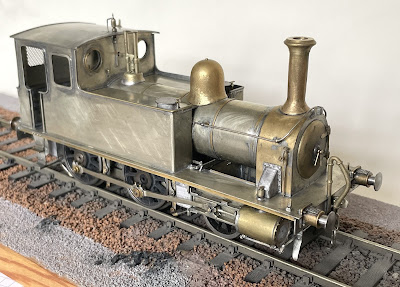 |
| Image of 118 cropped from a photo of a Scrap Tank at Inverness. |
I was unaware of the image above until it was brought to my notice by Charlie Wrigley while I was building my model of HR118 recently, despite the photo from which it is cropped being included in M.C.V. Alchin's "History of Highland Railway Locomotives", which sits on my bookshelf; I'd simply not noticed the diminutive engine sneaking partially into view beside a Scrap Tank at Inverness Roundhouse.
The buffer beam displays the abbreviation "No", with the "o" underlined, to the left of the hook and to the right, the number 118 with a small "A", discernible with the eye of faith, between the 8 and the vertical row of rivets, which points to the engine being turned out in Cumming's short-lived livery of 1915-22. The colour of the engine at this time is described as Moss Green and I'm fortunate to have a tin of Phoenix P728 (HR Dark Green 1912-23), now deleted from their list, which I hope will not disappoint.
The rivets on the buffer beam were a surprise to me and were modelled in retrospect, both the vertical rows, which fasten to the ends of the frames and the row along the top; I rivetted the rear buffer beam too as I presume it would have been similar. I noted that the couplings have been changed from the earlier photos to three-link ones, which confirms a shunting role. The lamp-iron on top of the smokebox is well seen in this view as is the vacuum pipe, which has been detached from the buffer beam presumably to allow the door to open.
Below the buffer beam can be seen the cylinder drain-cock operating shaft, which passes in front of the valve chest and is supported centrally by a bracket attached to this.
The additional information contained in this partial view is limited though it has helped with some constructional detail, in addition it shows that the engine was turned out in Cumming livery towards the end of her service which is the time-slot of my model.
PS. While rummaging through back issues of HRJ I noticed in No.56 for early 2001 an item in Highland Lines showed that "Home of 0 Gauge" listed a 7mm scale kit for HR118.






